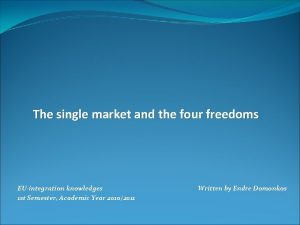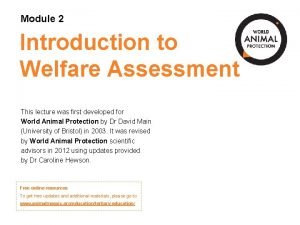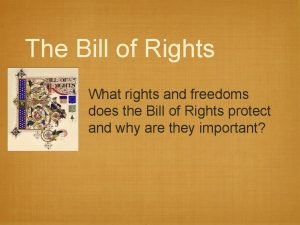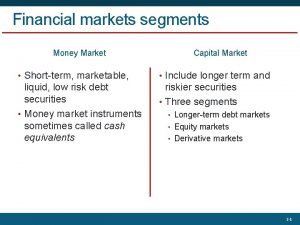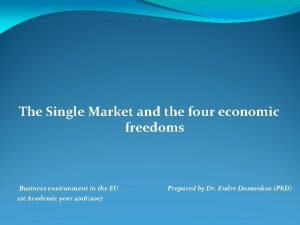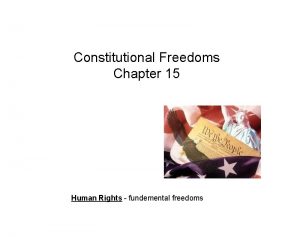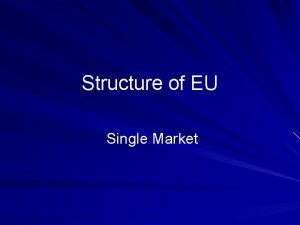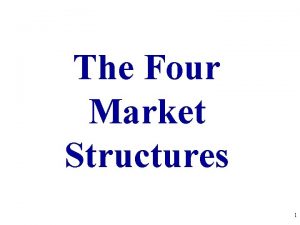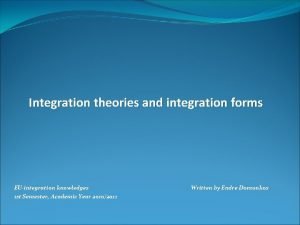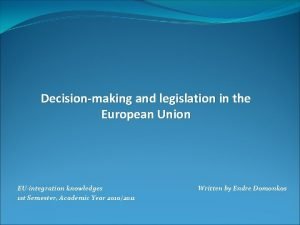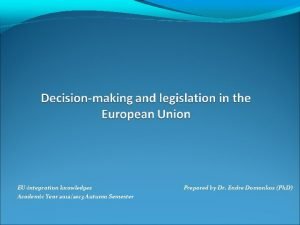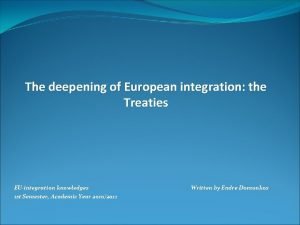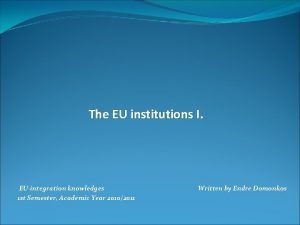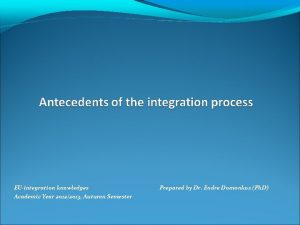The single market and the four freedoms EUintegration






















- Slides: 22

The single market and the four freedoms EU-integration knowledges 1 st Semester, Academic Year 2010/2011 Written by Endre Domonkos

I. The establishment of the single market I. The fundamental aim of establishing the European Economic Community was to create a common market for its Member States. The common market – replaced by the concept and objective of a single market or internal market after the Single European Act – is, and has always been, the fundamental motivation for European integration, taking primacy over all other ends. The common market is an area where goods, services, capital and workers move freely without any restrictions. Following the Treaty of Maastricht, the principle of free movement was extended from workers to persons in general. Although the Community was supposed to complete the building of a common market in the ‘ 70 s, the aim was only partially accomplished. Therefore the programme of the single market outlined in the Single European Act (SEA), signed on 18 February 1986, was aimed at achieving the four fundamental freedoms through the dismantling of various obstacles which still remained: physical (frontier formalities and border controls), financial (budgetary and tax rules) and technical (differences in Member State-legislation, standards and other rules). The creation of the single market necessitated the application of many deregulatory measures by the Member States as well as the adoption of about 300 pieces of Community legislation by 1 January 1993, the deadline set by the SEA for the completion of the internal market. The legislative process related to the single market continues even today.

I. The establishment of the single market II. To guarantee the ‘four fundamental freedoms’ (the free movement of goods, services, persons and capital), a comprehensive legal framework was needed between the Member States, which originally had different regulatory systems and traditions. As guaranteeing the single market and the four freedoms was the main aim of European integration, it is not surprising that Community legislation related to these areas provides the backbone of the acquis communautaire. Both the EC Treaty and secondary legal acts focus primarily on ensuring the efficient functioning of the single market. The four fundamental freedoms are guaranteed on the one hand by negative integration, that means the dismantling of factors that hinder free movement, and on the other hand by positive integration, that means the adoption of common rules, common policies and Community actions. The building of the single market is a process that is still continuing, and it will probably take a long time until it is completed. Although the acquis communautaire now extends to a wide range of areas, ensuring a single or harmonised legal framework, there are still a number of major obstacles to the full implementation of the single market. There are several financial, technical, legal or administrative regulations rooted in the differences in taxation systems, standards, state or national traditions that prevent the European Community from fully realising the dream of the single market.

II. The free movement of goods I. The essence of the concept of a single market is that the EU is a single economic area, functioning similarly to a national market. Thus the free movement of goods is possibly the most fundamental element of not only the single market, but also the Community as such. The free movement of goods (which is about free trade within the EU), is guaranteed by the creation of a customs union and the abolition of quantitative restrictions between Member States. The customs union means the elimination of customs duties and charges having equivalent effect to customs duties within the Community, as well as the pursuance of a common commercial (or trade) policy based on common customs tariffs applied vis-à-vis third countries. In order to achieve the aim of a customs union, as enshrined in the Treaty of Rome, the Member States abolished existing (and refrained from introducing new) customs duties and charges having equivalent effect levied on trade between each other. The Council decision of 26 July 1966 set the deadline of 1 July 1968 achieving that aim and this date was observed. Discriminatory taxation is also prohibited in the EU, which means that a Member State cannot directly or indirectly levy higher taxes on products coming from another Member State. There are, however, three exceptions when charges having equivalent effect may be levied. In certain exceptional cases (with strictly defined conditions), Member States may levy charges on importers or exporters if the authorities provide essential services of general interest to them (e. g. phytosanitary tests). A similar case is when a Community system (e. g. common agricultural policy) necessitates the levying of such exporters or importers. The third (strictly defined) exception concern levies on foreign products that have no domestic competition or no similar domestic substitutes, and thus the aim of the levy is clearly not to protect domestic producers or limit competition.

II. The free movement of goods II. In addition to the abolition of customs duties and charges having equivalent effect, the setting up of a Common Customs Tariff (or Common External Tariff) forms another important element of the customs union. The Common Customs Tariff is the main instrument for regulating trade with third countries. The Common Customs Tariff means that the customs duty levied on a product from a third country is the same, irrespective of which Member State imports the product, and that once the customs duty has been levied in one Member State, the product can be freely transported to any other Member State. Collected customs duties are paid into the Community budget, and not into the budget of the collecting country. However, Member States can keep part of the collected customs duties for administrative costs (This ratio is used to be 10%, but was changed to 25% from 2001). Common customs tariffs are thus a precondition for guaranteeing the free movement of goods within Member States. The Common Customs Tariffs was originally set in a Council Regulation in 1968, which, of course, has been subsequently amended and updated several times. This Council Regulation is put into effect by the Commission in the form of implementing regulations, which for example set the exact rate of tariffs. In addition to setting common tariffs, the Member States have also harmonised their customs regulations and procedures, simplified border control formalities and developed forms of cooperation in the field of customs.

II. The free movement of goods III. In order to guarantee the free movement of goods, in addition to the removal of customs duties, quantitative restrictions (trade and customs quotas) and measures with equivalent effect also had to be prohibited. Thus the Treaty of Rome provided for their elimination. While the removal of quantitative restrictions, just as in the case of customs duties, was relatively easy (quotas were removed by 31 December 1961), the elimination of measures with equivalent effect to quantitative restrictions posed serious difficulties and continues to do so even today, because such measures appear in diverse forms in individual Member State and have proved to be one of the most effective instruments of restricting trade. For a long time, to define measures with equivalent effect was problematic. Originally, the Commission derived the ban on such measures from a 1970 Directive. This Directive prohibited all national measures that did not create an equal framework for imported and domestic product or that made imports from other Member States more costly or difficult. Finally, in its ruling in the Dassonville case of 1974, the European Court of Justice gave a uniform definition of the concept of measures with equivalent effect to quantitative restrictions, which was wider that the scope of the Directive. In this, particular case, the Belgian Public Prosecutor had brought criminal proceedings against a French trader called Dassonville, who had imported a consignment of Scotch whisky from France without having a valid certificate of origin issued by the British customs authorities, as was required by the Belgian law.

II. The free movement of goods IV. The Court discovered that it was very difficult for someone importing whisky from a country other than the United Kingdom to obtain such certificate, and therefore this requirement impeded trade, and was thus considered a measure with equivalent effect to a quantitative restriction. The ECJ set down a general formula defining the scope of the concept of measures with equivalent effect to quantitative restrictions: „All trading rules enacted by Member States which are capable of hindering, directly or indirectly, actually or potentially intra-Community trade are to be considered as measures having an effect equivalent to quantitative restrictions. ” This has become known as the ‘Dassonville formula’. However, there ins an exception to the ban on imposing restrictions on trade. Article 30 (ex article 36) of the EC Treaty stipulated that the prohibition of quantitative restrictions and measures with equivalent effect shall not preclude restrictions on grounds of: public morality, public policy or public security; the protection of health and life of humans, animals or plants; the protection of national treasures possessing artistic, historic or archaeological value or the protection of industrial and commercial property. Article 30 also stipulates that such measures shall not constitute a means of arbitrary discrimination or disguised restriction on trade between Member States. Following the rulings of the European Court of Justice, restrictions within these categories may only be applied if they are proportionate to the objective to be achieved, namely that the objective could not be achieved by less restrictive means.

II. The free movement of goods V. Another important ruling of the ECJ was in the so-called Cassis de Dijon case of 1979, which – together with the Dassonville-formula – was a milestone not only in the removal of trade barriers, but also in the entire process of the approximation of legislation. It arose when a German firm was refuted permission to import a consignment of French Cassis de Dijon liqueur because of its inadequate alcoholic strength (15 -20%). This rendered it incompatible with the German legislation, which fixed a minimum alcohol percentage of 25% for fruit-based liqueurs. The case was brought before the ECJ, where the German authority argued in its defence that if gave up stricter regulations, it would have to align itself with the lowest common standards in the Community. Another argument raised by the defence and refuted by the Court was that there was an issue of public interest to consider, in that fixing a minimum alcohol content for liqueurs discouraged the proliferation of alcoholism among young people. The Court did not accept these arguments, and gave a ruling that was to have a profound impact on the acquis communautaire: the Court ruled that a product which has been lawfully produced and marketed in one Member State should be able to circulate lawfully throughout the entire Community. (This is known as the principle of equivalence). The Cassis de Dijon judgment pointed out the concept of mutual recognition, which means that obstacles to movement within the Community resulting from disparities between national laws must be accepted only insofar as those provisions are recognised by the ECJ as being necessary in order to satisfy mandatory requirements relating in particular to the effectiveness of financial supervision, the protection of public health, the fairness of commercial transactions and the protection of the consumer.

II. The free movement of goods VI. The possible restrictions listed in the Cassis de Dijon judgment are generally referred to as mandatory requirements, which should be strictly distinguished from the general and permanent exemptions from the prohibition of measures having equivalent effect to quantitative restrictions, listed in Article 30 (ex Article 36) of the Treaty. Mandatory requirements set by the Court are not valid forever but only until Community legislation covers the relevant field (thus different protective measures by Member States are only acceptable until then). Member States can refer to mandatory requirements in cases when national measures apply without distinction to imported and domestically produced goods alike. The Member State also has to be able to demonstrate that it restricts trade because the protection offered by legislation in the country of origin of the product in question is in some way inferior to the level of protection that its own laws provide for consumers. Germany failed to prove this in the Cassis de Dijon case. This temporary nature of mandatory requirements is indicated by the Court’s subsequent decisions, which extended their scope. The Cassis de Dijon ruling put an end to the Member States’ practice of protecting their national products with various rules and standards.

II. The free movement of goods VII. The principle of mutual recognition mounted an attack against protectionist national trade regulations and can be considered a turning point in establishing the truly unrestricted and free movement of goods. Mutual recognition practically became a new harmonisation mechanism in Community law, which was finally institutionalised by the Single European Act. Mutual recognition however does not mean that Member States have to adjust to the lowest national standards and requirements. The aim of the continuous exercise of extensive and thorough approximation of standards and technical specifications is to provide a solution to this problem. The Community is particularly active in laying down common framework rules for safety requirements. The enforcement of these rules is monitored by the Commission. This ensures confidence in the quality, reliability and effectiveness of quality control conducted by other Member States, which forms the basis for the practical implementation of mutual recognition. Member States must always inform the Commission in advance if they wish to introduce new standards or regulations.

III. The free movement of persons The universal right of free movement was no enshrined in the Treaty of Rome. In line with the main underlying objective of ensuring the proper functioning of the single market, the original Treaty only provided for the free movement of economically active persons (employees, selfemployed people and service providers) and their families. This changed gradually over the years and, finally, the Treaty of Maastricht introduced the freedom of movement as a fundamental right that all EU citizens have, irrespective of whether they have economic activity. There are still different rules for various groups, depending on the economic nature of their activities , if any. Three different freedoms apply to people taking up residence in another Member State for the purposes of work: the free movement of workers for workers (employees), the freedom of establishment for self-employed people and the freedom to provide services for service providers. The free movement of these three groups is based on the same underlying principle: non-discrimination. This means, for instance, that workers or self-employed entrepreneurs from other Member States have the same rights as those of the host state. It should be added, however that the three freedoms – the free movement of workers, the freedom of establishment and the freedom to provide services – are no unlimited rights. They only mean that natural or legal persons of all Member States are entitled to equal treatment irrespective of their nationality or country of origin.

III. The free movement of workers I. The freedom of movement for workers is fundamental pillar of European integration. Extending the conditions of labour mobility, on the one hand, expands employment opportunities and, on the other hand, makes it easier for employers to find people with the right qualifications and experience; this ultimately improves the employment situation and the efficiency of the economy in the Union as a whole. That is why the mobility of workers has been a key issue from the very beginning of the Communities. Nonetheless, the creation of specific conditions and the dismantling of various barriers in the Member States was a long and slow process. Even today, a mere 2% of the EU’s active population works in another Member State. The free movement of workers can be hampered by three conditions: 1) discrimination between workers based on nationality; 2) legislation or administrative action that set different conditions for workers from different Member States; 3) the lack of coordination between social security systems. Both the EC Treaty and subsequent Community legislation have been aimed at the abolition of such barriers. In addition to the prohibition of discrimination, in order to ensure the free movement of workers, Article 39 expressly stipulates the key rights of the workers of the Member States.

III. The free movement of workers II. According to Article 39, the key rights of workers of the Member States are the followings: - to accept actual offers or employment; - to move freely within the territory of Member States for the purpose of (seeking) employment; - to stay in a Member State for the purpose of employment in accordance with the same provisions laid down by law, regulation or administrative action as those governing the employment of nationals of that State; - to remain in the territory of a Member State after having been employed in that State, subject to conditions embodied in relevant Community regulations. The anti-discriminatory provisions of Article 39 also prohibit discrimination between workers from different Member States in terms of remuneration (including social and tax benefits), or any other conditions of work and employment. Under the secondary legislation of the Union, workers are entitled to bring with them their spouses and dependants (or children under the age of 21), even if they are not national of any Member State. However, the principle of the free movement of workers would not be very useful if workers lost their rights to social security benefits when moving from one Member State to another. For this reason, Article 42 of the EC Treaty stipulates that migrant workers can „carry over” the rights acquired (and the amounts accumulated, which are added to their entitlements is other Member States). This means that pensions are calculated aggregately on the basis of all entitlements in various Member States.

III. The free movement of workers III. Taking up employment in another Member State is also facilitated by the fact that workers can avoid not only double taxation, but also having to pay social security contributions in more than one Member State. The aim of the Treaty is clearly not to harmonise the social security systems of the Member States (they remain completely under national competence), but to create the necessary coordination between those systems. The Treaty made this a task for Community legislation, on the basis of which the Council has adopted several regulations. Council regulations are aimed at regulating the following areas: sickness pay, maternity allowance, family benefit, unemployment benefit, invalidity benefit, old-age pension, surviving spouse’s pension, benefits payable for industrial accidents or occupational illnesses and death grants. Workers (in an employed or self -employed capacity) as well as their family members are entitled to social security benefits. However, there are exemptions from the free movement of workers, whereby the Treaty allows for certain restrictions against foreign workers (from another Member State). According to Article 39 of the EC Treaty, such restrictions must be justified on grounds of public policy, public security or public health. Article 39 also allows for limitations to be applied in relation to a state’s public service. However, this does not mean that citizens of the Member States cannot be employed in the public service or that the employment of foreign citizens can be prohibited in every case. Such limitations can only be an exception to the rule and have to be properly justified. According to the interpretation of the ECJ, in the public service such prohibition can only be applied to employees with truly public service duties.

IV. The freedom of establishment I. Self-employed persons form a separate category based on Community law. This category includes those working in the so-called liberal professions (e. g. physicians, lawyers and architects) as well as different activities (e. g. retailers, wholesalers, craftsmen, agents and transport operators) many of whom provide services. These people are entitled to freedom of establishment, which means that they have the right to pursue their professional activities in any of the Member States, and to set up and run a firm or company according to the same rules that apply to the nationals of the host state. The main barrier to the freedom of establishment, which concerns both the freedom to provide services and, to some extent, the free movement of workers, stems from the problem that professional qualifications are often needed for the pursuit of certain professional activities. However, qualifications may vary greatly from one Member State to another in terms of their content and length, which makes it more difficult for citizens of other Member States to obtain a licence for the pursuit of professional activities. At first, this problem seemed to pose a huge challenge for the approximation of legislation in the Community. In the beginning, Member States tried to harmonise certain professions, which they succeeded in doing – often only after decades of negotiations – for certain professions (physicians, architects, chemists, etc. ), but eventually it became clear that extending this process to all professions was impossible.

IV. The freedom of establishment II. Thus, Member States extended the principle of „mutual recognition”, already introduced for the free movement of goods, to this area, with the adoption of two Directives: the first relating to higher-education diplomas and the second to other professional education and training. The mutual recognition of diplomas, degrees and certificates thus became a fundamental principle (both for people in a self-employed or employed capacity). In the case of the majority of professions, Member States mutually recognise diplomas issued by the others. Nonetheless, in certain professional fields (for example, law), the recognition of a person’s qualifications has to be requested from the local authorities. If the authorities establish a major disparity between the qualifications in terms of the lengthy or content of education, they may require proof of professional experience, an adaptation period of no more than three years or an aptitude test. The significance of the freedom of establishment is that it covers both natural persons and legal entities. For the latter, it means the right of so-called „secondary establishment” in another Member State, meaning the right to set up a branch or a subsidiary of an existing firm or company in another State. The specific conditions covering the establishment of legal persons are regulated by Council directives adopted on the basis of the Treaty. These directives are collectively referred to as Company Law Directives.

IV. The freedom of establishment III. It took the Member States 30 years of negotiations before they finally came to an agreement on the European Company Statute at the Nice Summit in December 2000. The European Company Statute is a legal instrument that gives companies the option of forming a European Company – known formally by its Latin name Societas Europeae” (SE) – in one of four ways: by the merger or two or more existing public limited companies from at least two different Member States; by the formation of a holding company by public or private limited companies from at least two different Member States; by the formation of a subsidiary of companies from at least two different Member States; or by the transformation of a public limited company which has, for at least two years, had a subsidiary in another Member State. In practice, this means that European Companies are able to operate throughout the EU on the basis of a single set of rules and a unified management and reporting system. There are exemptions from the freedom of establishment principle. Member States may impose certain restrictions on the grounds of public policy, public security or public health, as long as they are justified and proportionate to the objectives they are supposed to serve. According to Article 45 of the Treaty, such exemptions may be applied to activities that are connected, even occasionally, with the exercise of official authority. Similarly to restrictions on the free movement of workers, exemptions may only be applied in duly justified cases, appropriately supported by the strict interpretation practice of the European Court of Justice. The Council may, acting be a qualified majority on a proposal from the Commission, extend the scope of exemption to certain new activities.

V. The free movement of non-economically active persons I. With the Treaty of Maastricht, the freedom of movement became a fundamental right of every citizen of every Member State of the European Union. This is due to the fact that the Maastricht Treaty created the institution of Union citizenship and made the right to free movement a fundamental element of such citizenship. According to the Treaty, every citizen of any Member State is also a citizen of the Union. The latter does not replace nationality, but complements it by providing additional rights. Citizenship of the Union means four specific rights. A citizen of the European Union has the right: - to move, travel and stay freely in all Member States of the EU; - to vote and to stand as a candidate in municipal elections and elections to the European Parliament in the Member State of his residence; - to receive the protection of the consular and diplomatic authorities of any Member State when in the territory of a Non-Member State, if the citizen’s own country has no such authority there; - to petition the European Parliament or address a plea to the European Ombudsman for legal redress. According to the principle of the free movement of persons, it is a fundamental right of all Union citizens to be able to freely cross borders between Member States without any restrictions. There are no restrictions whatsoever on EU citizens on short-term visits (travelling). All citizens of the Union are free to travel to and stay in another Member State for a period of three months.

V. The free movement of non-economically active persons II. All limitations on goods purchased by travellers were also removed under the principle of free movement of goods and persons. Today, anybody can freely take any product purchased in another Member State for personal consumption back to his home country. Taxes on these products (VAT, excise duties) have to be paid at the point of purchase. As the EU is a single market, European citizens can no longer take advantage of „tax-free” or „duty-free” shopping at airports or ports; inside the Union, tax- or duty-free goods are only available for third-country citizens. Free movement involves not only the right to travel freely, but also the right to stay in any Member State for a sustained period, which includes the freedom to work, study, reside and stay in all Member States. This also means that citizens of the EU are free to choose their domicile in the area of the Union. However, if they intend to stay in a Member State for a period longer than three months, they need a residence permit. These permits are automatically issued if certain conditions – which depend on the purpose of residence – are fulfilled.

V. The free movement of non-economically active persons III. While for wage-earners, the conditions of free movement were already guaranteed by the Treaty of Rome and subsequent secondary legislation, for residence for other purposes the Council adopted three Directives on 28 June 1990, which regulate the general framework rules on the right of residence for noneconomically active persons, the conditions governing the right of residence of people who have ceased their occupational activity (pensioners) and the conditions applicable to persons staying in another Member State for educational purposes (students). The main aim of the Directives is to regulate the conditions upon which citizens of another Member State may be entitled to a residence permit. According to the provisions of the first Directive, nationals of Member States have the right of residence in other Member States, provided that they can demonstrate that they have sufficient resources to avoid becoming a burden on the social assistance system of the host Member State. The second Directive grants the right of residence to retired people, if they are recipients of a pension or an amount sufficient to avoid becoming a burden on the social security system of the host Member States. The Directive 93/96/EC applies to students who reside in another Member State specifically for educational purposes, and who are not studying as family members of migrant workers or of self-employed persons. The latter enjoy the same rights as students who are nationals of the host Member State (e. g. they are entitled social benefits to which foreigners are not generally entitled). According to the provisions of the third Directive students have the freedom to choose to attend an educational institution in any Member State, but have to obtain a residence permit for the duration of their studies.

V. The free movement of non-economically active persons IV. The permit is issued automatically, provided that the student is enrolled in a recognised educational establishment, is covered by sickness insurance and has sufficient resources to avoid becoming a burden on the social security system of the host Member State during his or her period of residence. Free movement and travel to other Member States is facilitated by the fact that there are practically no border controls inside the EU. By integrating the Schengen Agreement and subsequent Schengen legislation (the so-called Schengen acquis) into the European Union and the acquis communautaire, the Amsterdam Treaty largely removed controls on passenger traffic on borders within the Union, except for the United Kingdom and Ireland. Border controls are now only carried out at the external borders. Persons crossing from one Member State to another can do so freely, while those who have entered from a third country can move on freely without any controls to other Member States. Moreover, citizens of the Union can cross the border with their identity cards (rather than passports). In relation to the dismantling of internal border controls and the free movement of persons, in order to ensure their national security, Member States have adopted common regulations in the area of visa policy, asylum policy, external border controls and judicial cooperation in civil affairs; these issues fall within the field of cooperation in justice and home affairs.

Thank you for your attention!
 Four freedoms of the eu
Four freedoms of the eu Four freedoms of the eu
Four freedoms of the eu Animal welfare inputs and outputs
Animal welfare inputs and outputs Freedoms foundation teacher programs
Freedoms foundation teacher programs Freedoms
Freedoms Freedoms
Freedoms Chapter 19 civil liberties first amendment freedoms
Chapter 19 civil liberties first amendment freedoms Civil liberties first amendment freedoms
Civil liberties first amendment freedoms Requirements for effective segmentation
Requirements for effective segmentation Hypothetical market structure
Hypothetical market structure Shape with one side
Shape with one side Sisd processor
Sisd processor Single instruction single data
Single instruction single data Waiting line management
Waiting line management Primary target market and secondary target market
Primary target market and secondary target market Participants in the business buying process
Participants in the business buying process Bond equivalent yield formula
Bond equivalent yield formula Market identification
Market identification Document sample
Document sample Commercial bill
Commercial bill One seller complete barriers to market entry
One seller complete barriers to market entry Skin assessment charting
Skin assessment charting What are the different market forms and meat cuts
What are the different market forms and meat cuts
